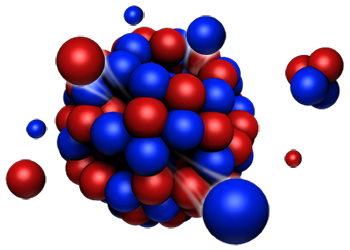Conveners
Operations/Safety: Radiation Safety
- Erik Johnson (STFC UKRI)
Operations/Safety: Operations 1
- David Haynes (ISIS, STFC, UKRI)
The Rutherford Appleton Laboratory has over 60 years of history with proton accelerator operations and neutron science. Since 1983 the “ISIS Spallation Neutron and Muon Source” has continued this work. Now ISIS must manage the ongoing generation of radioactive waste and deal with both its and the site’s historic radioactive legacy.
The formation of radioactivity is an undesirable, yet...
During operations at the European Spallation Source (ESS), the high power proton beam will generate penetrating fast neutrons in the tungsten target, creating a significant inventory of nuclides in the target and adjacent components and structures. A systematic process has been executed to identify, evaluate, and prevent or control accidental events that potentially create a radiological...
The European Spallation Source is currently under construction in Lund, Sweden. Once completed it will deliver the highest quality of long-pulse neutron beams for fundamental and applied scientific research. Last year in 2018 commissioning of the ion source and the LEBT started and will continue with the start of operation of the test stand for the cryo-cavities this autumn and the...
The Rutherford Appleton Laboratory, based in Oxfordshire, UK, has a long history of proton accelerator operations. In late 1984 the first neutrons were produced in the ISIS Neutron and Muon Source and operations have continued since then and expanded with the opening of the second target station in 2008.
The solid waste items produced from operation of ISIS are all considered against their...
The European Spallation Source (ESS), now under construction in Lund, Sweden, will be the largest and most advanced neutron scattering facility in the world. In order to produce high-energy neutrons through the spallation process, a 2 GeV proton beam will interact with a Tungsten target. This interaction may cause an erosion of the target and the release of radionuclides into its helium...
The TS1 project; a circa £15M, 9-year (from definition to planned completion) technically complex sustainability project, to realise a raft of benefits for ISIS and allow continued running and development of TS1, has continued to progress since the update provided at ICANS XXII [1] and now has firm dates for the operational shutdown within which the bulk of the strip-out, installation and...
The ISIS long shutdown 2020 -2021 is set to be a busy time; it is during this period that the strip-out, installation and commissioning of the TS1 project [1], [2] will occur. Marking the culmination and actualisation of nearly 8 years of preparation and work. The TS1 project is not the only large project taking advantage of the shutdown and with the significant amount of work to do and...
With a nominal beam power of nearly 1.4 MW, the PSI High Intensity Proton Accelerator (HIPA) is currently at the forefront of the high intensity frontier of particle accelerators. Key issues of this facility are minimization of beam losses as well as safe operation of the SINQ spallation source. Particular attention is being recently paid towards an improved understanding of the properties of...
The target of the European spallation source (ESS) consists of a rotating wheel, divided up into 36 cassettes containing tungsten. The wheel is flanged to a 6m long shaft. Primal the rotation speed and the position of the target wheel are defined and measured by the drive unit at the top of the shaft. However there are degrees of freedom which cannot be measured by the drive unit e.g....
The European Spallation Source (ESS) will be a 5 MW neutron spallation research facility where an energetic proton beam incident upon a helium-cooled tungsten target is converted to neutron beams. From a radiation safety perspective, the helium cooling system, the tungsten wheel rotating system and the vacuum in the monolith vessel containing the tungsten wheel concentrate the most critical...
Ultra-cold neutrons (UCN) are an important experimental tool to advance the understand of particle physics, nuclear physics, astrophysics, and cosmology. Unfortunately, many of these UCN experiments are statistically limited. To help to overcome these limitations, we are proposing a so-called inverse target geometry. While this geometry has clear advantage for the production of neutrons, it...

